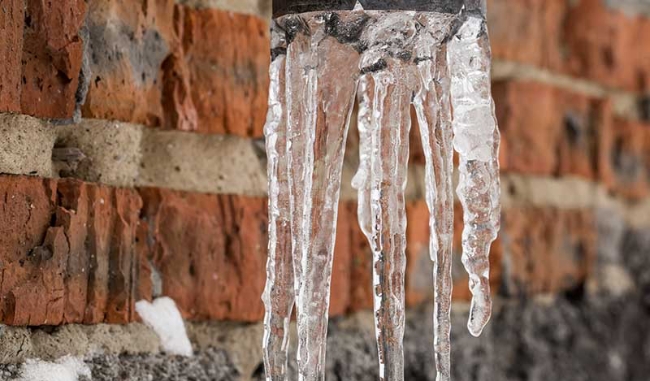Avoiding Your Pipes from Cold Weather: Top Methods
Avoiding Your Pipes from Cold Weather: Top Methods
Blog Article
We have stumbled upon the article involving Prevent Frozen Pipes down the page on the web and felt it made good sense to write about it with you over here.
:strip_icc()/snow-outdoor-faucet-pipes-4af65d1e5e904fb1aa7bf74071fe5d89.jpg)
Cold weather can ruin your pipes, especially by freezing pipes. Below's how to stop it from happening and what to do if it does.
Introduction
As temperatures drop, the risk of icy pipes increases, possibly leading to expensive fixings and water damage. Recognizing how to prevent icy pipes is critical for property owners in chilly climates.
Comprehending Frozen Pipes
What causes pipes to ice up?
Pipelines ice up when subjected to temperatures below 32 ° F (0 ° C) for extended periods. As water inside the pipelines ices up, it broadens, putting pressure on the pipeline walls and potentially creating them to rupture.
Risks and problems
Frozen pipelines can result in supply of water disturbances, property damage, and pricey repair work. Ruptured pipelines can flood homes and create comprehensive structural damage.
Signs of Frozen Pipeline
Identifying frozen pipes early can stop them from bursting.
Exactly how to identify frozen pipelines
Search for decreased water flow from faucets, uncommon smells or noises from pipes, and noticeable frost on revealed pipes.
Prevention Tips
Shielding vulnerable pipes
Cover pipelines in insulation sleeves or make use of warmth tape to safeguard them from freezing temperature levels. Concentrate on pipes in unheated or outside areas of the home.
Heating techniques
Keep indoor spaces effectively warmed, specifically locations with pipes. Open cupboard doors to enable cozy air to circulate around pipes under sinks.
Safeguarding Exterior Plumbing
Garden hose pipes and exterior faucets
Separate and drain garden hose pipes prior to winter season. Install frost-proof faucets or cover exterior faucets with insulated caps.
What to Do If Your Pipelines Freeze
Immediate actions to take
If you suspect icy pipelines, keep taps open up to relieve pressure as the ice thaws. Use a hairdryer or towels soaked in hot water to thaw pipes slowly.
Long-Term Solutions
Architectural modifications
Consider rerouting pipes far from outside wall surfaces or unheated locations. Add extra insulation to attics, basements, and crawl spaces.
Updating insulation
Buy premium insulation for pipelines, attic rooms, and wall surfaces. Correct insulation aids preserve constant temperatures and minimizes the risk of icy pipelines.
Verdict
Protecting against icy pipes needs positive procedures and quick responses. By understanding the causes, indications, and safety nets, homeowners can safeguard their plumbing during cold weather.
5 Ways to Prevent Frozen Pipes
Drain Outdoor Faucets and Disconnect Hoses
First, close the shut-off valve that controls the flow of water in the pipe to your outdoor faucet. Then, head outside to disconnect and drain your hose and open the outdoor faucet to allow the water to completely drain out of the line. Turn off the faucet when done. Finally, head back to the shut-off valve and drain the remaining water inside the pipe into a bucket or container. Additionally, if you have a home irrigation system, you should consider hiring an expert to clear the system of water each year.
Insulate Pipes
One of the best and most cost-effective methods for preventing frozen water pipes is to wrap your pipes with insulation. This is especially important for areas in your home that aren’t exposed to heat, such as an attic. We suggest using foam sleeves, which can typically be found at your local hardware store.
Keep Heat Running at 65
Your pipes are located inside your walls, and the temperature there is much colder than the rest of the house. To prevent your pipes from freezing, The Insurance Information Institute suggests that you keep your home heated to at least 65 degrees, even when traveling. You may want to invest in smart devices that can keep an eye on the temperature in your home while you’re away.
Leave Water Dripping
Moving water — even a small trickle — can prevent ice from forming inside your pipes. When freezing temps are imminent, start a drip of water from all faucets that serve exposed pipes. Leaving a few faucets running will also help relieve pressure inside the pipes and help prevent a rupture if the water inside freezes.
Open Cupboard Doors
Warm your kitchen and bathroom pipes by opening cupboards and vanities. You should also leave your interior doors ajar to help warm air circulate evenly throughout your home.

I'm just very interested in Winter Plumbing Precautions: Preventing Frozen Pipes and I hope you enjoyed our post. Feel free to take the opportunity to distribute this blog entry if you enjoyed it. Thanks so much for taking the time to read it.
Call Today Report this page